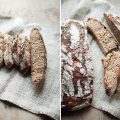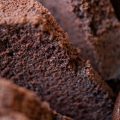As an introduction to Sicily, I would like to share with you this recipe for sourdough bread with 100% semolina flour or pane di semola rimacinata. This bread is sweat, soft, and…just look at that yellow color! It’s just like Sicily in my memory – sunny side up. Let’s hop to the recipe for semolina sourdough bread I’m sure you’ll love, too.
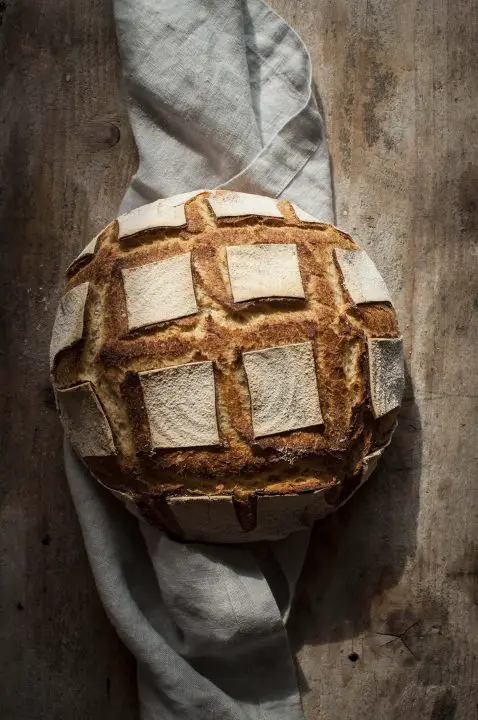
Table of Contents
Print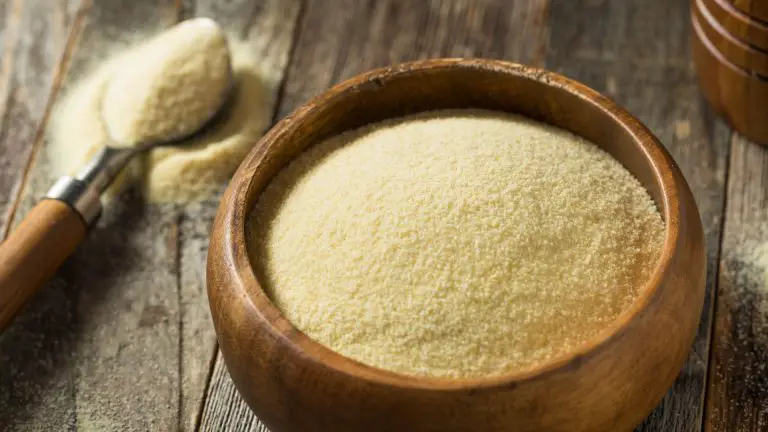
100% Pane Di Semola Rimacinata
- Total Time: 16 hrs 50 mins
- Yield: 1 medium-sized loaf 1x
Ingredients
Starter
- 70 g of your (active) mother sourdough starter
- 250 g of semolina flour (farina di semola rimacinata)
- 225 g of water
Dough
- 300 g of semolina flour
- 200 g of water
- 9 g salt
Instructions
Starter
- In the evening, prepare the starter. Mix 70 g of your (active) mother sourdough starter, 250 g of semolina flour and 225 g water. Cover and leave to ferment overnight until doubled in volume and bubbly.
Dough
- In the morning, prepare the dough. Mix 200 g of water and all of the above starter. Add flour and mix until all the flour is incorporated and then knead the dough for 5 minutes. Next, leave the dough to rest for 1 hour.
- Once one hour has passed, add salt and incorporate it well into the dough. Also, check if the dough is stiff and it needs more water. If you want to add some addins like seeds or pistachios, now it’s the time.
- Knead the dough again for 5 minutes and then pre-shape it into boule (round loaf) and leave it to rest covered for 10 minutes. In the meantime, prepare the rising basket – dust it well with flour or line a rising basket with a table cloth and dust it with flour.
- After 10 minutes have passed, shape the dough into boule and place it into rising basket smooth surface-down. Leave the dough to rise until it increases in volume and passes the poking test – make an indent with finger into the dough and observe the reaction – if the indent springs back slowly, the dough is ready to be put into oven, if it spring back quickly, leave it to rise a little bit longer.
Baking
- At least 30 minutes before baking preheat your oven to the maximum temperature of your oven along with Dutch oven or a baking stone. I used Dutch oven.
- When the oven is preheated, take the loaf out of the rising basket, score it with a blade or sharp knife and transfer it to Dutch oven. Put your Dutch oven into oven.
- Bake the loaf for 20 minutes with the lid on at 240°C/465F°F and 25-30 minutes with lid off at 230°C/445°F and until bread gets nice dark color.
Notes
- Starter for this bread was prepared in the evening, the dough was mixed in the morning, left to rest 1 hour and then left to rise until fully proofed for another 3 hours.
- My dough needed 3 hours, yours might need more or less, depending on the activity of your starter and ambient temperature.
- Prep Time: 16 hrs 20 mins
- Cook Time: 30 mins
- Category: bread
You know that feeling when you travel somewhere and it feels good, almost like home, and it feels like soul has anchored? I had this feeling when visiting Sicily a year and a half ago. I promised myself to come back. I didn’t know when and I haven’t been making any plans to come back, I just let the thought of it somewhere at the back of my mind and to puzzle itself on its own.
Guess what? Now it’s that time go come back. I’m just about to leave for Sicily in couple of hours.
And the best part of it? This trip will all be about sourdough breads and flours.
If we were to find a place of (heritage) grains revival and wheat grain diversity, then Sicily is an absolute gem. Sicily is well known for its fertile soil, which makes it perfect for cereals cultivation. It is no suprise that Sicily gained title “the granary of Rome” in the Roman times. Nowadays, more and more farmers and millers are getting aware of the importance of grain preservation of old and healthier grain varieties.
All this wouldn’t have been possible without the Clear Sicily international team that I’m very grateful to be the part of. Clear Sicily is all about being passionate about Sicily, its products and people. And it is more and more inspired by breads and flours.
In the next ten days we’ll travel around Sicily and get to know it personally. And bake a lot of sourdough bread!
As an introduction to Sicily, I would like to share with you recipe for sourdough bread with 100% semolina flour or pane di semola rimacinata. This bread is sweat, soft, and…just look at that yellow color! It’s just like Sicily in my memory – sunny side up.
Semolina is coarsely ground durum wheat (grano duro, Triticum durum – a variety of wheat) and it’s often used to make pasta.
When it’s called semola rimacinata in italian, it reffers to semolina which has been re-milled to make it finer and more suitable for bread baking. There is a vast variety of breads in southern Italy made with semola rimacinata, like Pane di Altamura (Provincia di Bari), or Mafalda and Pane di Lentini in Sicily to name just a few. The natural yellow color comes from carotenoids present in the grain.
And now, let’s hop to the recipe.
100% Pane Di Semola Rimacinata – Semolina Bread Recipe
Baking Schedule
Starter for this bread was prepared in the evening, the dough was mixed in the morning, left to rest 1 hour and then left to rise until fully proofed for another 3 hours.
Ingredients
Yield: 1 medium-sized loaf
Starter
- 70 g of your (active) mother sourdough starter
- 250 g of semolina flour (farina di semola rimacinata)
- 225 g of water
Dough
- 300 g of semolina flour
- 200 g of water
- 9 g salt
Instructions
Starter
- In the evening, prepare the starter. Mix 70 g of your (active) mother sourdough starter, 250 g of semolina flour and 225 g water. Cover and leave to ferment overnight until doubled in volume and bubbly.
Dough
- In the morning, prepare the dough. Mix 200 g of water and all of the above starter. Add flour and mix until all the bread flour is incorporated and then knead the dough for 5 minutes. Next, leave the dough to rest for 1 hour.
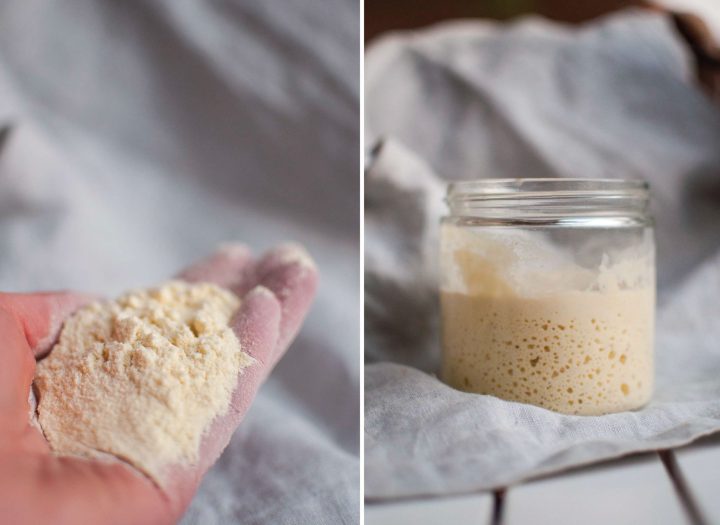
- Once one hour has passed, add salt and incorporate it well into the dough. Also, check if the dough is stiff and it needs more water. If you want to add some add-ins like seeds or pistachios, now it’s the time.
- Knead the dough again for 5 minutes and then pre-shape it into boule (round loaf). Let the dough rest covered for 10 minutes. In the meantime, prepare the rising basket – dust it well with flour or line a rising basket with a table cloth and dust it with flour.
- After 10 minutes have passed, shape the dough into boule and place it into rising basket smooth surface-down. Leave the dough to rise until it increases in volume and passes the poking test – make an indent with finger into the dough and observe the reaction – if the indent springs back slowly, the dough is ready to be put into oven, if it spring back quickly, leave it to rise a little bit longer. My dough needed 3 hours, yours might need more or less, depending on the activity of your starter and ambient temperature.
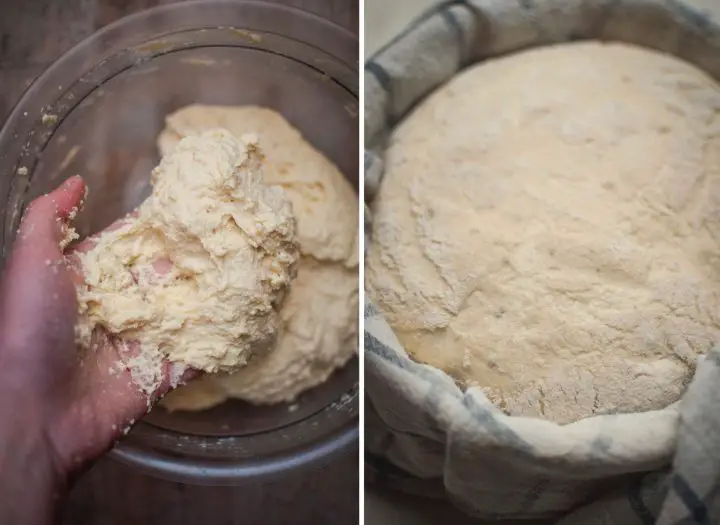
Baking
- At least 30 minutes before baking bread, preheat your oven to the maximum temperature of your oven along with Dutch oven or a baking stone. I used Dutch oven.
- When the oven is preheated, take the loaf out of the rising basket, score it with a blade or sharp knife and transfer it to Dutch oven. Put your Dutch oven into oven.
- Bake the loaf for 20 minutes with the lid on at 240°C/465F°F and 25-30 minutes with lid off at 230°C/445°F and until bread gets nice dark color.
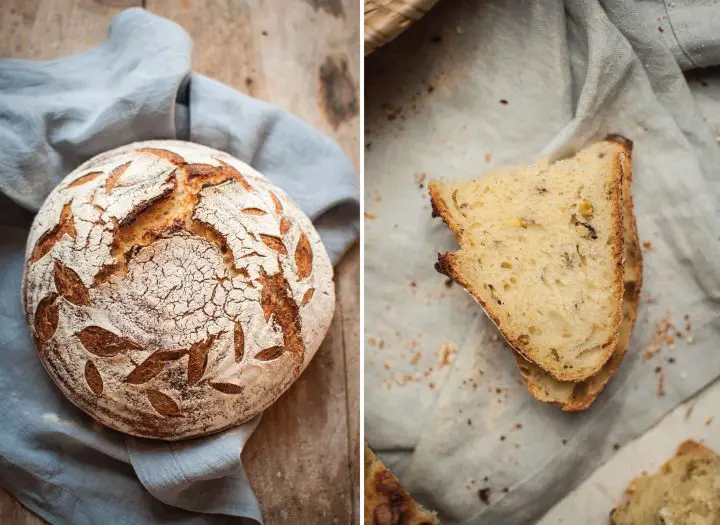
I also found this recipe for limoncello Italian wedding cookies that eased my nostalgia for the Amalfi coast!
Other sourdough recipes you might love:
- Rustic Rye Sourdough Bread With Milk Kefir
- Sourdough Walnut Swirl Bread Recipe
- Sourdough Oatmeal Bread
- Sourdough Bialys
Enjoy your delicious sourdough bread. Talk soon and stay tuned!
Semolina Sourdough Bread – FAQs
Is semolina good for sourdough?
Yes, semolina can be a good addition to sourdough bread. Its texture can help add structure to the dough and create a chewy texture in the final bread.
When using semolina in sourdough bread, it’s important to note that it can absorb more water than all-purpose flour, so you may need to adjust your recipe accordingly by adding more water to the dough. Additionally, semolina can make the dough harder to handle and shape, so it’s best to mix it with another flour like all-purpose flour or bread flour.
Can I use semolina for sourdough starter?
It’s not recommended to use semolina to create a sourdough starter. This is because semolina flour doesn’t contain enough natural yeast and bacteria to effectively ferment the mixture and create a healthy and active starter.


